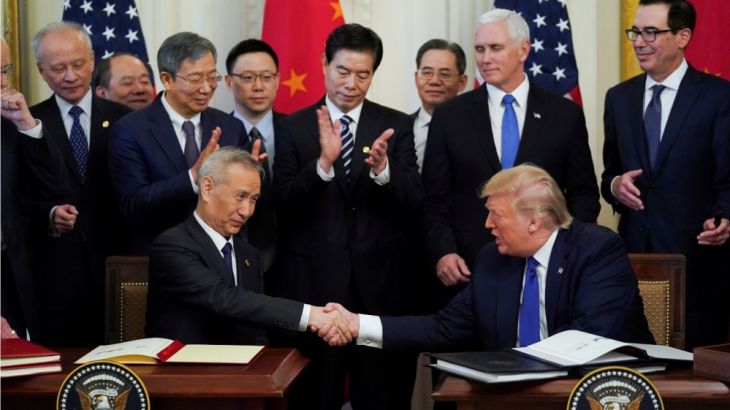
Did China capitulate to the US on ‘beautiful monster’ trade deal?
Trump’s ‘monster’ deal and how Xi Jinping wasted his political capital. Plus, Russia’s pipeline to the East and South.
Three years ago Chinese President Xi Jinping stood in front of the world’s business elite in Davos, defending the post-war international liberal order as President Donald Trump railed against globalisation.
Now, 18 months later, a trade deal of sorts has been signed. The deal, whichever way you choose to break it down, is a win for Trump who argues the agreement delivers “economic justice” for the country.
Keep reading
list of 4 itemsEcuador weighs security, international arbitration in latest referendum
‘Triple spending’: Zimbabweans bear cost of changing to new ZiG currency
Boeing hit with 32 whistleblower claims, as dead worker’s case reviewed
Has Xi wasted the political capital he established?
China’s treatment of 13 million Uighur Muslims, tactics against democracy protesters in Hong Kong, and removal of presidential term limits – giving Xi indefinite power to stay as leader – have created uncertainty, cramping growth both at home and abroad.
Still, China has agreed to buy $200bn of US goods over two years, including $32bn in additional agricultural products. And tariffs on $360bn of Chinese goods will remain in place until after the US election or China proves it is in compliance with the deal.
But there is little confidence in that target being met because American farmers may never be able to produce enough. Plus, US companies will no longer need to hand over their technology to gain access to the Chinese market.
Greg Swenson, partner at investment bank Brigg Macadam, tells Al Jazeera that the new deal with China is a win for Trump and a win for the US, arguing that the Chinese economy could not handle the tariffs imposed on its export-dependent economy and ageing population.
“They did lose the battle politically, there’s not a lot of support. They have basically isolated themselves for a number of reasons and I think President [Trump] has done a really good job of exposing some of the flaws or some of the real problems with the Chinese model,” Swenson says.
He adds: “It’s important to know that the rest of the world is very much aware of the Chinese state-owned enterprise model and the risk that poses to the rest of the world as well as the military, security intelligence, and human rights issues.”
Russia’s pivot to the East and South
Boxed in by sanctions imposed on Russia following the annexation of Crimea and backing an uprising in the east of Ukraine, Russia’s President Vladimir Putin has been working hard to reduce reliance on the West.
First came the opening of a $55bn pipeline to supply gas to China, completing Putin’s so-called pivot to the East. And this month, Russia opened a pipeline through Turkey to supply southern Europe, further punishing Ukraine, which now stands to lose billions in transit fees, for strained relations between the two neighbours.
Russia currently supplies 40 percent of Europe’s gas. The proposed pipeline will provide more gas for Turkey and open up markets in Bulgaria, Serbia and Hungary. It comes as Russia’s biggest gas company, Gazprom, was forced to halt construction of another pipeline under pressure from the US.
Gulmira Rzayeva, founder and managing director for Eurasia Analytics, explains that when it comes to gas exports from Russia to Turkey, the political dimensions and existing tensions have not affected energy exports.
“This is an interdependent issue and Turkey, as much as Russia, has depended on the export and import of natural gas.”